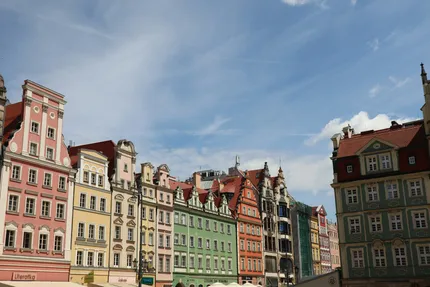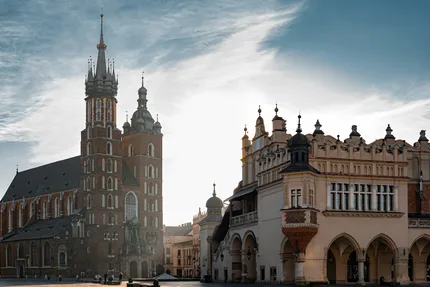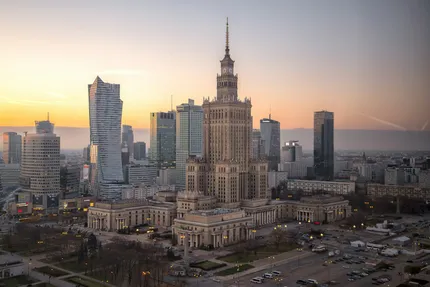CityTouring
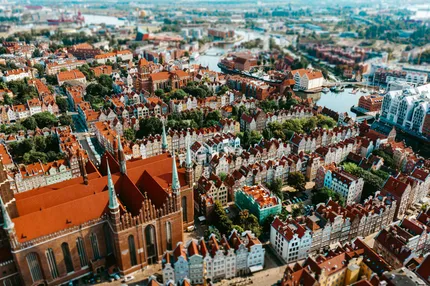
City trip to Gdansk
PolandGdańsk, a Polish gem on the Baltic Sea, is a city rich in history, architectural beauty, and cultural significance. This charming city is renowned for its meticulously restored old town, featuring quaint cobblestone streets, colorful facades, and the imposing Gothic St. Mary’s Church, one of the world's largest brick churches. As a major seaport, Gdańsk's history as a trading hub can be felt along the iconic Long Market, where merchants once conducted bustling trade. Visitors can delve into history at the European Solidarity Centre, which offers insight into Poland’s political transformation, or explore the Museum of World War II for a compelling look into the city's role during the conflict.
The Motlawa River embankment with its historic crane and scenic views creates a captivating backdrop for leisurely strolls, enjoying local cuisine in waterfront cafes, or sailing on yachts. Gdańsk is also known for its amber, earning it the nickname 'Amber Capital'. Amber enthusiasts can enjoy shopping for these unique gemstones or delve into the Amber Museum to learn more about this fossilized resin. The blend of historic intrigue, maritime atmosphere, and vibrant modern culture makes Gdańsk an alluring destination for travelers.
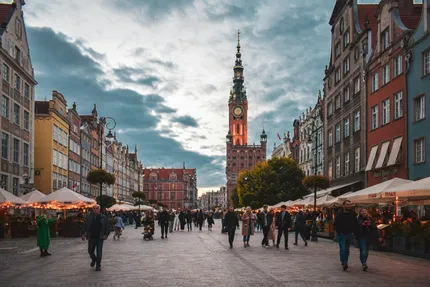
Old Town
Old Town in Gdansk is a picturesque area known for its historic architecture and vibrant cultural life. Featuring landmarks like the Neptune Fountain and St. Mary's Church, it offers a glimpse into Gdansk's rich past. Cobblestone streets, charming cafes, and artisan shops create a lively atmosphere, making it a popular spot for both locals and tourists.
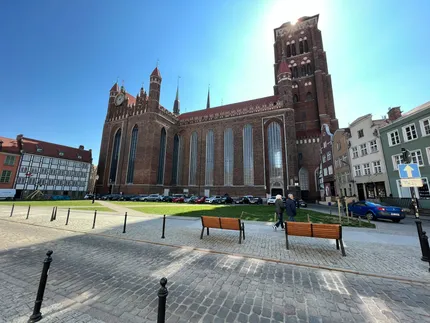
St. Mary's Church
St. Mary's Church in Gdansk is one of the largest brick churches in the world. This Gothic masterpiece, completed in 1502, boasts impressive architecture and houses numerous valuable artworks, including a medieval astronomical clock. Visitors can climb the tower for panoramic views of the city, making it a must-see landmark for history enthusiasts and architectural admirers alike.
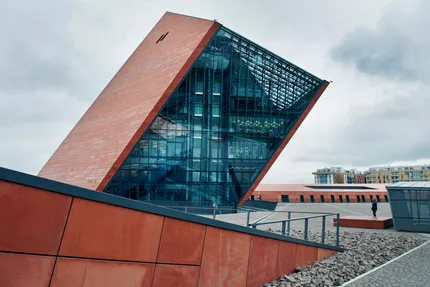
Museum of the Second World War
The Museum of the Second World War in Gdansk offers a comprehensive overview of World War II, featuring exhibits that cover the conflict's causes, its global impact, and the post-war consequences. Visitors can explore thousands of artifacts, documents, and personal accounts, providing a profound understanding of the war. The museum's modern architecture and multimedia displays ensure an engaging and educational experience.
Gdańsk is an ideal destination for history enthusiasts and culture seekers. The city’s profound historical significance, particularly regarding World War II and the Solidarność (Solidarity) movement, offers a rich tableau for those interested in exploring pivotal moments in history. Architectural admirers will relish the beautifully restored Gothic and Renaissance structures throughout the town. For those drawn to the sea, Gdańsk’s maritime heritage and picturesque waterfront are perfect for leisurely exploration or enjoying boat tours. The city also attracts shoppers and art lovers, especially those interested in amber, with its numerous boutiques and specialty stores. A family-friendly city, Gdańsk offers easy access to nearby beaches and parks, making it suitable for a relaxed vacation with children.
Foodies will appreciate the city's culinary scene, which combines traditional Polish dishes with fresh seafood from the Baltic. Moreover, tech enthusiasts might find interest in Gdańsk’s burgeoning status as a tech hub in Poland. Overall, Gdańsk caters to a variety of interests, making it an accommodating choice for solo travelers, couples, families, and small groups looking for a diverse and enriching travel experience in Northern Europe.
Three top reasons for a city trip to Gdansk
- Visit Gdansk's Old Town for its historic architecture, including the stunning St. Mary's Church and the charming Long Market, full of colorful merchant houses.
- Explore the European Solidarity Centre, a modern museum dedicated to the history of the Solidarity movement, pivotal in ending Communist rule in Poland.
- Enjoy a scenic stroll along the Motlawa River, featuring picturesque views, traditional Polish cuisine at waterfront restaurants, and nearby cultural landmarks like the Crane.
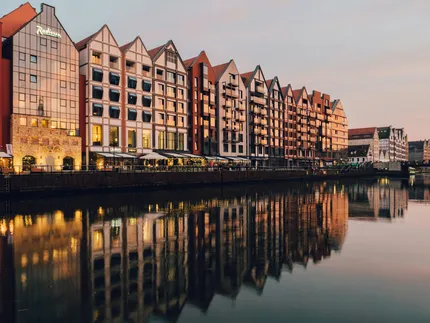
Best time to visit Gdansk
The best time to visit Gdańsk is during the late spring and summer months, from May to September. This period offers the most pleasant weather and longer daylight hours, perfect for exploring the city’s historic sites and enjoying outdoor activities along the Baltic coast. Average temperatures range from 15°C to 25°C (59°F to 77°F), providing a comfortable climate for sightseeing. These months also align with various cultural events and festivals, such as the St. Dominic's Fair in July and August, which is one of the largest and oldest trade fairs in Europe, adding an extra layer of excitement to any visit.
More activities and things to see in Gdansk:
European Solidarity Centre
The European Solidarity Centre in Gdansk honors the Solidarity movement's struggle against communism in Poland. This modern museum features interactive exhibits, multimedia displays, and archival resources. Visitors learn about the pivotal role of the movement in shaping European history, and the center also hosts cultural events, workshops, and conferences promoting freedom, democracy, and human rights.
Westerplatte
Westerplatte is a peninsula in Gdansk, Poland, known for its historical significance as the site where World War II began on September 1, 1939. Visitors can explore the open-air museum featuring war relics, bunkers, and memorials dedicated to the defenders of Poland. The area offers a poignant insight into the past and picturesque views of the Baltic Sea.
Gdańsk Shipyard
The Gdańsk Shipyard, historically known as Lenin Shipyard, is where the Solidarity movement began in 1980, playing a pivotal role in ending Communist rule in Poland. Visitors can explore the European Solidarity Centre nearby, which offers exhibits on Poland’s struggle for freedom. The shipyard’s industrial landscape also attracts those interested in maritime heritage and the area’s ongoing revitalization projects.
Long Market
Long Market, also known as Długi Targ, is a historic and vibrant pedestrian street in Gdansk, Poland. It serves as a key tourist attraction, showcasing colorful facades and impressive architecture. The market is home to notable landmarks like Neptune's Fountain and Artus Court. Visitors can enjoy a variety of shops, restaurants, and cafés while soaking in the rich history and lively atmosphere.
Amber Museum
The Amber Museum in Gdansk showcases an impressive collection of amber artifacts, highlighting both its historical significance and artistic expression. Explore exhibits featuring ancient amber inclusions, intricate jewelry, and sculptures that tell the story of the region's long-standing relationship with this precious resin. The museum's setting in a former prison tower adds a unique historical layer to the experience.
Oliwa Cathedral
Oliwa Cathedral, located in Gdansk, is renowned for its stunning architecture and magnificent organ concerts. Originating from the 12th century, this Gothic structure showcases exquisite Baroque and Rococo interior designs. Visitors can explore its tranquil gardens and experience the awe-inspiring acoustics during the organ performances, creating a serene atmosphere in this historic religious site.
Artus Court
Artus Court in Gdansk is a historic merchant's meeting house situated on the city's main square, Długi Targ. Originally built in the 14th century and reconstructed over time, it reflects Gothic architectural styles. Now a museum, its richly decorated interiors showcase Gdansk's mercantile history and the lavish lifestyle of its wealthy traders, featuring a grand hall with detailed frescoes and exhibits of period artifacts.
Brzeźno Pier
Brzeźno Pier, located in Gdansk, offers visitors a peaceful retreat with scenic views of the Baltic Sea. This wooden pier stretches into the water, making it a favorite spot for leisurely strolls and enjoying the sea breeze. The area around the pier is equipped with amenities like cafes and walking trails, ideal for enjoying a relaxing day by the seaside.
Crane (Żuraw)
The Crane (Żuraw) in Gdansk is a striking symbol of the city's maritime heritage. As a medieval port crane and gate, it was historically used to load cargo and install ship masts on the Motława River. Today, it is part of the National Maritime Museum, offering visitors insights into the port's history and stunning vistas of the old town and river.
Getting around in Gdansk
Gdansk, a city on the Baltic coast of Poland, offers convenient ways to get around for both residents and tourists. The city center is quite pedestrian-friendly, with many attractions accessible by foot. For cycling enthusiasts, dedicated lanes and bike-sharing systems make it easy to explore the city on two wheels. The public transportation network, consisting of buses and trams, is efficient, affordable, and covers most areas, making it unnecessary to rent a car for getting around the city. A valid ticket gives travelers access to both buses and trams within the same fare zone, with various options for time-limited or day passes. For travel to Sopot or Gdynia within the Tricity area, the SKM (Fast Urban Railway) is a quick and reliable option that connects the neighboring cities seamlessly.
Getting to Gdansk
To reach Gdansk, the Gdansk Lech Walesa Airport is the closest, located just about 12 km from the city center. The airport offers a mix of domestic and international flights, with connections to major European cities like London, Stockholm, and Amsterdam. Travelers can easily reach downtown Gdansk from the airport via a 30-minute ride on the Airport Shuttle Bus 210 or by taxi. For those preferring trains, Gdansk Glowny is the main station, connecting the city with Warsaw and other Polish cities as well as offering some international links, primarily through Berlin, via the Polish national railway service. Additionally, long-distance buses operated by companies such as FlixBus provide connections across Europe, making the city accessible for those traveling on a budget.
